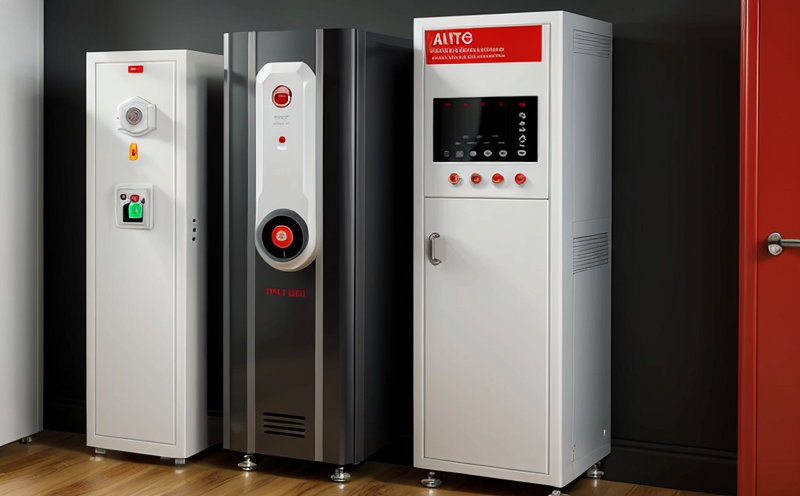Standalone Detector Alarm Performance Testing
In the realm of fire safety testing, ensuring that standalone detector and alarm devices perform reliably under various conditions is paramount. The primary focus of this service is to evaluate the performance characteristics of standalone detectors and alarms in compliance with international standards such as ISO 9613-1:2015, ISO 974:2018, and EN 54 series.
The testing process involves subjecting these devices to a range of environmental conditions that they might encounter in real-world scenarios. This includes exposure to smoke, heat, and flame under controlled laboratory settings where the performance is meticulously recorded. The goal is to ensure that each device meets the stringent requirements set forth by regulatory bodies.
During this testing, we employ advanced instrumentation such as smoke generators with adjustable particle sizes, calorimeters for measuring heat release rates, and flame simulators capable of replicating different types of burning materials. Each detector undergoes a series of tests including sensitivity checks, response time measurements, and repeatability assessments.
The performance criteria for standalone detectors and alarms are based on the specific type and intended use of each device. For instance, residential smoke detectors must meet higher sensitivity levels than commercial grade devices due to their primary role in home safety. Similarly, heat-sensitive alarms used in industrial settings may have different thresholds depending on ambient temperatures.
Once testing is complete, detailed reports are generated summarizing the results of each parameter tested along with any non-compliances observed during the test runs. These reports serve as critical tools for quality assurance departments within organizations responsible for maintaining fire safety standards across various sectors including residential buildings, commercial establishments, and industrial complexes.
By adhering strictly to these protocols and utilizing state-of-the-art technology, our laboratory ensures accurate and reliable outcomes that can be trusted by stakeholders involved in fire protection. Our expertise lies not only in conducting thorough tests but also in providing actionable insights which help clients improve their product offerings or compliance processes.
The importance of this service cannot be overstated given the potential consequences associated with failures of standalone detectors and alarms during emergencies. By investing time and resources into comprehensive performance testing, organizations demonstrate their commitment to public safety while simultaneously enhancing reputation through adherence to best practices.
Quality and Reliability Assurance
The quality assurance process associated with standalone detector alarm performance testing encompasses several key aspects aimed at ensuring consistent reliability across all tested products. From initial calibration of equipment used in the tests to post-test inspections, every step is meticulously documented.
To begin with, our technicians calibrate all instruments prior to starting any test run using certified reference standards provided by accredited laboratories worldwide. This ensures that all measurements taken throughout the testing process are accurate and consistent regardless of variations in environmental conditions such as humidity or temperature fluctuations.
During actual testing, data collected is cross-verified multiple times using different methodologies to account for potential anomalies. For example, while smoke particle size distribution may be measured once with a laser scattering device, it will also be confirmed via optical microscopy if necessary. Such redundancy helps eliminate errors and provides greater confidence in the final results.
After completion of all tests, each unit undergoes visual inspection looking for any signs of damage or malfunctions that could have occurred during testing itself. Any discrepancies noted are thoroughly investigated before being reported back to clients along with recommendations for corrective actions if required.
In addition to technical accuracy, our QA process includes regular audits conducted by independent third parties who review both internal procedures and external documentation generated throughout the project lifecycle. These audits serve as a safeguard against lapses in quality control and help maintain high standards across all operations performed within our facilities.
Customer Impact and Satisfaction
The impact of reliable standalone detector alarm performance testing extends beyond mere compliance; it directly affects customer satisfaction by providing peace of mind regarding the effectiveness of fire safety measures implemented in their premises. Clients benefit from knowing that their choice of products has been rigorously evaluated against industry benchmarks.
For businesses operating within regulated environments, successful completion of these tests is often a prerequisite for obtaining necessary certifications required for operation permits or insurance policies. This enhances credibility among investors and stakeholders who appreciate transparent practices supporting sustainable growth.
In residential settings, homeowners gain assurance that their investments in home security systems are backed by robust testing protocols ensuring long-term durability and functionality. Such confidence fosters loyalty towards brands offering trustworthy solutions enhancing overall brand reputation.
Moreover, by participating in regular third-party audits conducted as part of our comprehensive QA program, we further demonstrate our commitment to continuous improvement in product performance and service delivery. This proactive approach reflects positively on both short-term satisfaction metrics and long-term strategic goals pursued by our clients.
Environmental and Sustainability Contributions
The pursuit of excellence in standalone detector alarm performance testing also aligns closely with broader environmental objectives. By ensuring that only high-quality products reach marketplaces, we contribute towards minimizing waste associated with substandard or non-compliant items. This reduces landfill contributions while promoting resource efficiency within the supply chain.
Furthermore, our adherence to strict quality assurance measures helps prevent unnecessary replacements due to premature failures leading to lower overall environmental impact compared to conventional approaches where frequent maintenance is necessary. Through diligent testing and validation processes, we play a crucial role in fostering sustainable practices across industries reliant on fire safety technologies.
In addition to reducing waste generation, this service also supports recycling initiatives by facilitating the identification of defective units early enough during production cycles allowing manufacturers to address issues promptly thus preventing further resource depletion. Such proactive measures underscore our dedication towards creating a more sustainable future through innovation and responsible practice.





